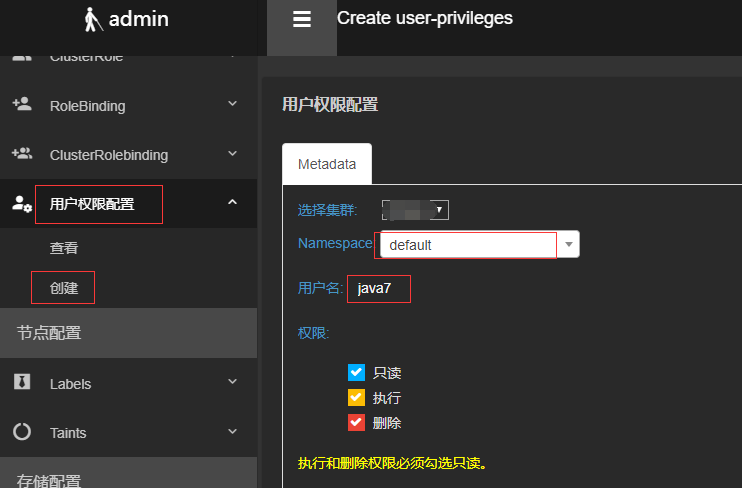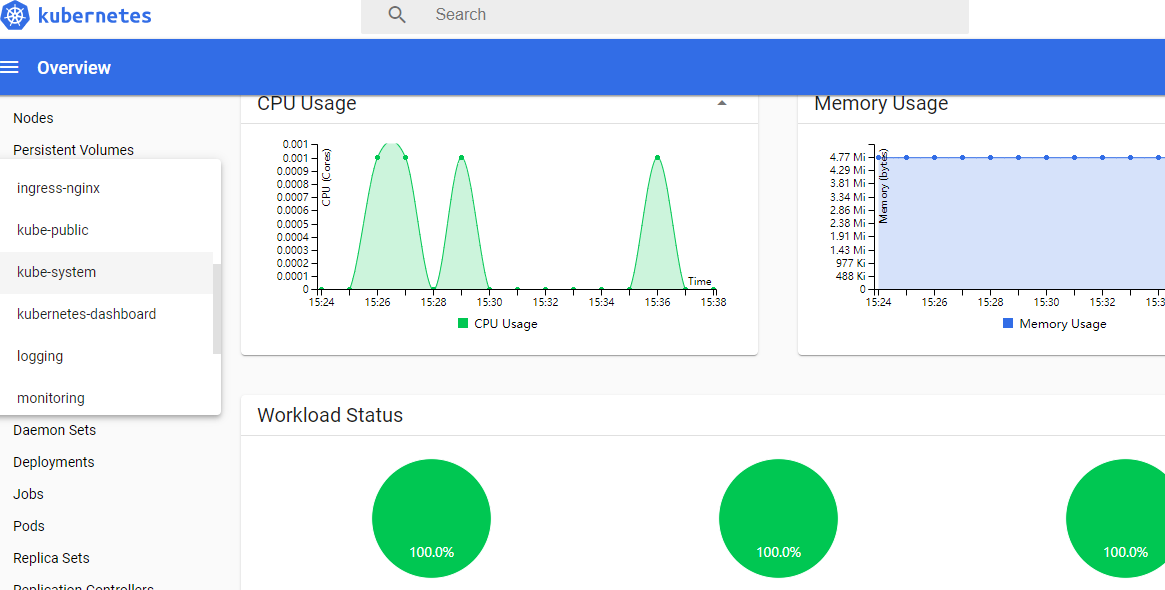1、基本说明
在生产环境使用k8s以后,大部分应用都实现了高可用,不仅降低了维护成本,也简化了很多应用的部署成本,但是同时也带来了诸多问题。比如开发可能需要查看自己的应用状态、连接信息、日志、执行命令等。
使用k8s后,业务应用以Pod为单位,不像之前的以服务器为单位,可以直接通过登录服务器进行相关操作。当业务应用使用k8s部署后,k8s官方的dashboard虽然可以进行查看日志、执行命令等基本操作,但是作为运维人员,不想让开发操作或查看自己范围之外的Pod,此时就要使用RBAC进行相关的权限配置。
本文章主要讲解两方面的问题:
- 使用用户名密码登录Dashboard
- 对已登录用户进行权限配置,实现只能操作自己Namespace的Pod,不能进入到未授权的其他Namespace
2、更改Dashboard认证方式
为了方便开发和运维人员登录Dashboard,需要将Dashboard登录方式用户名密码认证(用户名密码和Token可以同时开启)。
使用Ratel将kubernetes-dashboard的deployment的--authentication-mode改成basic即可,未安装Ratel的可以使用kubectl edit进行更改,更改完成会自动重启。

之后更改kube-apiserver配置添加--basic-auth-file=/etc/kubernetes/basic_auth_file
basic_auth_file为存储账号密码的文件,格式如下:
xxx1_2019,xxx1,3,"system:authentication" xxx2_2019,xxx2,4,"system:authentication" xxx3_2019,xxx3,5,"system:authentication" xxx4_2019,xxx4,6,"system:authentication"
依次是密码、用户名、ID号、用户组,因为下面会为已登录的用户进行授权,所以把组设置成了system:authentication,按需更改。
3、添加默认权限
首先配置一个system:authentication组允许查询namespace列表(因为进入到指定namespace,必须能list该集群的namespace):
apiVersion: rbac.authorization.k8s.io/v1 kind: ClusterRole metadata: annotations: rbac.authorization.kubernetes.io/autoupdate: "true" labels: kubernetes.io/bootstrapping: rbac-defaults rbac.authorization.k8s.io/aggregate-to-edit: "true" name: ratel-namespace-readonly rules: - apiGroups: - "" resources: - namespaces verbs: - get - list - watch - apiGroups: - metrics.k8s.io resources: - pods verbs: - get - list - watch --- apiVersion: rbac.authorization.k8s.io/v1 kind: ClusterRoleBinding metadata: name: ratel-namespace-readonly roleRef: apiGroup: rbac.authorization.k8s.io kind: ClusterRole name: ratel-namespace-readonly subjects: - apiGroup: rbac.authorization.k8s.io kind: Group name: system:authentication
创建查看namespace资源的权限
apiVersion: rbac.authorization.k8s.io/v1 kind: ClusterRole metadata: name: ratel-resource-readonly rules: - apiGroups: - "" resources: - configmaps - endpoints - persistentvolumeclaims - pods - replicationcontrollers - replicationcontrollers/scale - serviceaccounts - services verbs: - get - list - watch - apiGroups: - "" resources: - bindings - events - limitranges - namespaces/status - pods/log - pods/status - replicationcontrollers/status - resourcequotas - resourcequotas/status verbs: - get - list - watch - apiGroups: - "" resources: - namespaces verbs: - get - list - watch - apiGroups: - apps resources: - controllerrevisions - daemonsets - deployments - deployments/scale - replicasets - replicasets/scale - statefulsets - statefulsets/scale verbs: - get - list - watch - apiGroups: - autoscaling resources: - horizontalpodautoscalers verbs: - get - list - watch - apiGroups: - batch resources: - cronjobs - jobs verbs: - get - list - watch - apiGroups: - extensions resources: - daemonsets - deployments - deployments/scale - ingresses - networkpolicies - replicasets - replicasets/scale - replicationcontrollers/scale verbs: - get - list - watch - apiGroups: - policy resources: - poddisruptionbudgets verbs: - get - list - watch - apiGroups: - networking.k8s.io resources: - networkpolicies verbs: - get - list - watch - apiGroups: - metrics.k8s.io resources: - pods verbs: - get - list - watch
创建Pod执行权限
apiVersion: rbac.authorization.k8s.io/v1 kind: ClusterRole metadata: name: ratel-pod-exec rules: - apiGroups: - "" resources: - pods - pods/log verbs: - get - list - apiGroups: - "" resources: - pods/exec verbs: - create
创建Pod删除权限
apiVersion: rbac.authorization.k8s.io/v1 kind: ClusterRole metadata: name: ratel-pod-delete rules: - apiGroups: - "" resources: - pods verbs: - get - list - delete
上述权限创建完成后,只需要将对应的用户绑定对应的权限即可实现不同的用户在不同的namespace实现不同的权限。
对RBAC不熟悉的可以参考https://www.cnblogs.com/dukuan/p/9948063.html
或者参考书籍《再也不踩坑的Kubernetes实战指南》第二章。
4、配置权限
案例:假设有一个用户叫java7,需要访问default命名空间下的资源,可以在容器执行命令和查看日志
添加权限之前是不能查看任何信息的:

配置权限:
方式一:使用Ratel一键配置,选择对应的集群、Namespace、用户名、勾选权限点击创建即可。 

创建成功后再次登录,即可查看该Namespace的信息

查看日志:

执行命令:

同时也不能查看其他namespace的资源

方式二:使用yaml文件配置
使用Ratel进行权限配置,在配置权限后在对应的namespace下创建对应的RoleBinding,如下:
[root@k8s-master01 ~]# kubectl get rolebinding NAME AGE gitlab 112d ratel-pod-delete-java7 11m ratel-pod-exec-java7 11m ratel-resource-readonly-java7 11m
内容如下:
ource-readonly-java7 -o yaml apiVersion: v1 items: - apiVersion: rbac.authorization.k8s.io/v1 kind: RoleBinding metadata: creationTimestamp: "2019-12-03T07:34:24Z" name: ratel-pod-delete-java7 namespace: default resourceVersion: "35887290" selfLink: /apis/rbac.authorization.k8s.io/v1/namespaces/default/rolebindings/ratel-pod-delete-java7 uid: 547f5d42-159f-11ea-b1b5-001e674e3dd6 roleRef: apiGroup: rbac.authorization.k8s.io kind: ClusterRole name: ratel-pod-delete subjects: - apiGroup: rbac.authorization.k8s.io kind: User name: java7 - apiVersion: rbac.authorization.k8s.io/v1 kind: RoleBinding metadata: creationTimestamp: "2019-12-03T07:34:24Z" name: ratel-pod-exec-java7 namespace: default resourceVersion: "35887289" selfLink: /apis/rbac.authorization.k8s.io/v1/namespaces/default/rolebindings/ratel-pod-exec-java7 uid: 547c5768-159f-11ea-b1b5-001e674e3dd6 roleRef: apiGroup: rbac.authorization.k8s.io kind: ClusterRole name: ratel-pod-exec subjects: - apiGroup: rbac.authorization.k8s.io kind: User name: java7 - apiVersion: rbac.authorization.k8s.io/v1 kind: RoleBinding metadata: creationTimestamp: "2019-12-03T07:34:24Z" name: ratel-resource-readonly-java7 namespace: default resourceVersion: "35887288" selfLink: /apis/rbac.authorization.k8s.io/v1/namespaces/default/rolebindings/ratel-resource-readonly-java7 uid: 5476577f-159f-11ea-b1b5-001e674e3dd6 roleRef: apiGroup: rbac.authorization.k8s.io kind: ClusterRole name: ratel-resource-readonly subjects: - apiGroup: rbac.authorization.k8s.io kind: User name: java7 kind: List metadata: resourceVersion: "" selfLink: ""
在没有安装Ratel的情况下,可以使用上述yaml内容直接创建至对应的namespace下即可完成权限配置。
上述只是实现了对常用资源的权限控制,其他权限控制类似。
Kubernetes多集群资源管理平台Ratel安装可以参考:https://github.com/dotbalo/ratel-doc
